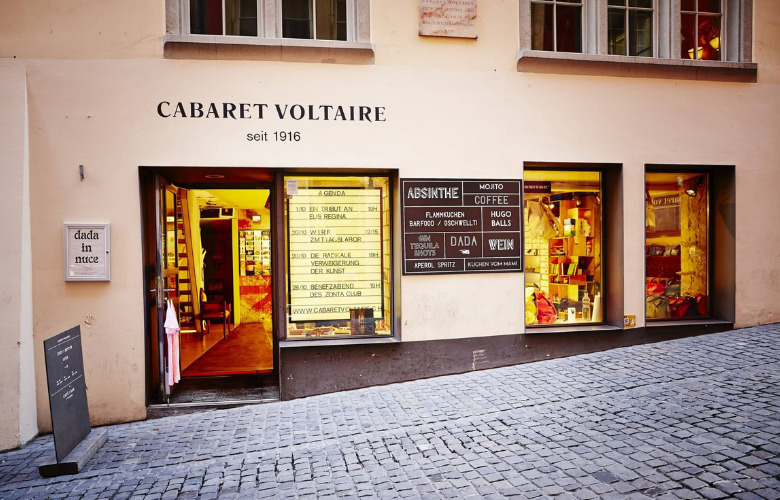
The Cabaret Voltaire is the birthplace of the world-famous Dada movement, which started in Zurich in 1916. In the middle of the First World War, Dada awakened the desire to question the present with new and surprising forms of artistic performance, expressed through music, literature, dance, and painting.
Hugo Ball and his companion Emmy Hennings founded the Cabaret Voltaire in the middle of Zurich’s Old Town, at Spiegelgasse 1, in 1916.
It was meant to be a cabaret for artistic and political purposes.
Other founding members were Marcel Janco, Richard Huelsenbeck, Tristan Tzara, and Sophie Taeuber-Arp and Jean Arp.
Switzerland was a neutral country during World War I, and among the many refugees coming to Zürich were artists from all over Europe.
Ball and Hennings approached Ephraim Jan, patron of the Hollaendische Meierei at Spiegelgasse 1, which had already hosted Zürich’s first literary cabaret, the Pantagruel in 1915.
Jan permitted them to use the back room for events. The press release on 2 February 1916 announcing the opening of the club reads:
“The Cabaret Voltaire. Under this name a group of young artists and writers has formed with the object of becoming a center for artistic entertainment. In principle, the Cabaret will be run by artists, permanent guests, who, following their daily reunions, will give musical or literary performances. Young Zürich artists, of all tendencies, are invited to join us with suggestions and proposals.”
The cabaret featured spoken word, dance and music.
The soirees were often raucous events with artists experimenting with new forms of performance, such as sound poetry and simultaneous poetry.
Mirroring the maelstrom of World War I raging around it, the art Cabaret Voltaire exhibited was often chaotic and brutal.
On at least one occasion, the audience attacked the artists on stage.
Though the cabaret was to be the birthplace of the Dadaist movement, it featured artists from every sector of the avant-garde, including Futurism’s Marinetti.
The cabaret exhibited radically experimental artists, many of whom went on to change the face of their artistic disciplines; featured artists included Wassily Kandinsky, Paul Klee, Giorgio de Chirico, Sophie Taeuber-Arp, and Max Ernst.
In June 1916, Ball had also published a journal with the same name. It featured work from artists such as the poet Guillaume Apollinaire and had a cover designed by Arp.
The cabaret closed down in the summer of 1916.
After the turn of the millennium, the building which had housed Cabaret Voltaire in 1916 fell into disrepair. And in the winter of 2001/2002 a group of artists describing themselves as neo-Dadaists, organized by Mark Divo, squatted the building to protest its planned closure.
They declared that it was a signal for a new generation of artists to align themselves with a revival of Dada.
Thankfully this active protest convinced the city of Zurich to preserve the historically important Cabaret Voltaire.
Soon after the protest in 2002, a new cabaret opened in the building.
With an extensive programme of events such as, Hugo Ball: Fuga saeculi, in 2008, as well as a film projection by Werner Nekes, and the 2008 exhibition Dreamachine: David Woodard, Sheela Birnstiel, Christian Kracht.
On Martin Luther King Day in January of 2017, I was one of the authors in a reading held by Writers Resist. On that memorable night, 10 authors read from their own works. Each of us then also read from a work of a famous author who highlighted the human condition.
All texts which were presented centred around human rights and equality.
After our reading, we remained on the podium and engaged on a lively, hour-long discussion with the audience. It was an incredible feeling to be on that stage where such great minds had come before us.
To this day, the artists’ locale in the nostalgic old town of Zurich (called “Niederdorf”) continues to serve as a platform for contemporary art and debates by holding exhibitions and soirées.
During the day, visitors can read and work in the historical hall. In the evenings, the place is transformed into a bar, where lively parties are held.
In the entrance area is the Dada library and the display area of an eclectic selection of literature the new Cabaret Voltaire is offering for sale.
Official Website Cabaret Voltaire
https://www.cabaretvoltaire.ch
Dada Manifesto explained at Widewalls
https://www.widewalls.ch/magazine/dada-manifesto
Zurich Film Festival – an Interview with Aurel Graf
The Extraordinary Cinema Culture of Zurich, Switzerland


Liam Klenk was born in Central Europe and has since lived on four continents. Liam has always been engaged in creative pursuits, ranging from photography and graphic design, to writing short stories and poetry, to working in theatre and shows. In 2016, Liam published his first book and memoir, 'Paralian'.
Read Full Profile© 2021 TheatreArtLife. All rights reserved.

Thank you so much for reading, but you have now reached your free article limit for this month.
Our contributors are currently writing more articles for you to enjoy.
To keep reading, all you have to do is become a subscriber and then you can read unlimited articles anytime.
Your investment will help us continue to ignite connections across the globe in live entertainment and build this community for industry professionals.